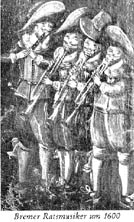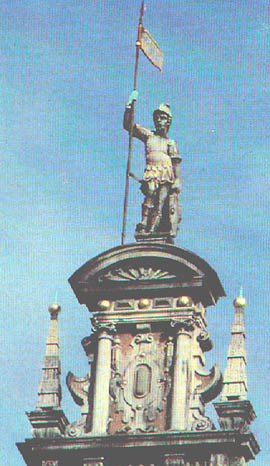
The construction period was from 1405 until 1410. In 1604 it was reconstructed in the Renaissance-style.
At first the carrier of the wheater flag, which is on very top of the building.

The Town Hall of Bremen
During the Middle Ages the Town Hall was seen as an overt sign of the power and pride of the citizens in the development of their independent town.
The Town Hall of Bremen is a building of multiple function. The style of construction is called "Hall-Floor" construction. The form of architecture and the displayed artifacts demonstrate the political self-confidence and the civil structure of the Free Town.
The market activities took place on the grand floor. There was a market hall in addition to the market place. Here was the place for the public weights and measures, the inland revenue office, the war cashbox, the money changers and the market court. There were also public events with amusements. This old drawing shows for example some of the Rathaus musicians ...

The construction period was from 1405 until 1410. In 1604 it was reconstructed in the Renaissance-style.
At first the carrier of the wheater flag, which is on very top of the building.

The Front of the Townhall
To the Meaning of the Figures: the King / Emperor and the seven Prince Electors
1. The figures are no portraits, they are only symbolically. The seven Prince Electors of the German Reich, who select the King / the Emperor ( 3 clerical, 4 secular ) are shown.The "Goldene Bulle" of Karl IV. (1356) gave the seven prince electors the exclusively right to elect the German King or Emperor, first time the Pope in Rome is out of the question.
This subjekt is to see in other townhalls (Aachen , Mainz ), too. The figure of the German King or Emperor on the left side of the townhall is presented by the imperial crown, the screptre, and the orb.
All eight figures mean religious and worldly rule/reign and power in those days in the German Reich.
This eight figures had been already at the gothic townhall before the conversion of Lüder von Bentheim. They were dated by discovery of old calculation books at 1400.
2. During the conversion/ renovation of Lüder von Bentheim (1609 - 1612 ) this eight figures were kept. They just move outside because of the oriel. But two changes were made, which can´t be seen at the first vieuw. The imperial canopy was put to another place. It got the religious Prince Elector from Cologne. The King of Böhmen got a second console. Why ?
Actually quite easy! In 1517 after the reformation several archbishops and Prince Electors joined the Protestant Church and gave their citizen freedom of worship.
In Cologne the archbishops had to resign four times, because they wanted to marry. Between Cologne and Bremen there had already been a comection. So the prince electors were revalued, the Emperor was devaluated, because he was the representative of the old catholic power.
In Böhmen the King had to respekt the different religions of his country, that was a spectacular event at that time. Normally the King of a country decided himself the religion. As a result the King of Böhmen got an revaluation on the townhall front, the second console.
So the gothic figures got to the original importance another one. The worldly Prince Electors faced the religious Prince Electors. Special circumstances in Böhmen and Cologne were expressed with hardly noticeable changes.
The Obere Rathaushalle
Lüder von Bentheim - The builder of the Town Hall of Bremen
The Bentheims moved one generation before from the Netherlands to Bremen. Already Lüder’s father Herman von Bentheim was a stonemason in Bremen.
In 1585 Lüder Bentheim became a munipical architect.
" Die Stadtwaage" (Townbalance) was built by Lüder von Bentheim in 1587, too.
In 1591 Lüder von Bentheim built "Das Kornhaus" near to the Weser.
In 1592 Lüder became a guildprincipal and also built " Die Ratsapotheke"
and " Das Akzisehaus ".
1594 Lüder built the new marketside from the "Schütting" in Bremen.
1595-1597 he led the work at the townhall in Leiden (Netherlands).
In the 16th century the Council of Bremen decided to construct a new facade, they commissioned Lüder von Bentheim to design it.
In 1605 the works at the Bremer Rathaus began. They continued until 1616. Unfortunately Lüder died during the work before they could finish.
We worked it out from "Das Rathaus zu Bremen" und "Das Bremer Rathaus", Bremen (S. 16 / 21-22)